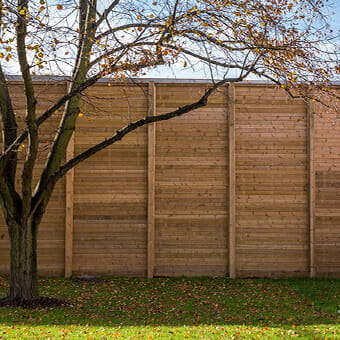Our other sites:
The effects of frequent loud noise can be extensive; increasing stress, interfering with sleep and much more. The World Health Organisation (WHO) recommends outdoor sound levels of 50 dBA to prevent people becoming ‘moderately annoyed’, but many of the noises we encounter on a daily basis exceed this recommendation.
Incorporating acoustic barriers can reduce the amount of noise pollution in an area, either through reflecting or absorbing sound from the source. To help you understand what to expect from acoustic fencing, we’ve answered the most common questions about it here:
What kind of sound reduction can I expect?
First of all we would strongly recommend contacting a qualified sound engineer who will specify the type, length and most critically, the correct height of the barrier to ensure optimum performance is achieved. There are a variety of factors which should be taken into consideration before purchasing your acoustic barrier, which include the surrounding environment, the proximity of the noise source to the barrier and the receiver. A realistic dB reduction could be between 9-15 decibels – this reduction to the human ear represents a halving of sound. If you consider road traffic rates as 70dB and conversational speech at 60dB, that’s a dramatic drop in volume! Be aware that although the term 'sound proof fencing' is often used, a fence cannot completely sound proof an outdoor space, but it will make a considerable difference.
What makes an acoustic fence different from a normal fence?
There are a host of factors that differentiates a certified acoustic fence from a normal domestic fence but the key differences are the following
An acoustic barrier requires a minimum surface mass density of at least 10kg per M2. This is because a mass of this weight will start to reflect noise back, rather than allowing it to simply travel straight through– a domestic fence produces circa 4kg per M2 whereas the Jakoustic barrier produces 25kg!
An acoustic barrier needs to be completely imperforate so sound cannot travel through – a domestic fence by nature will generally have some gaps throughout it’s design, after all, it’s designed for screening only and not to reduce noise.
An acoustic barrier should have a life of at least 20 years. Be sure to check that the fence actually comes with a guarantee and not just an expected lifespan. Fortunately for our customers' peace of mind, all of Jacksons products, regardless whether it’s an acoustic fence or not, are guaranteed for 25 years against rot, insect attack, and manufacturing defects.
Is sound reduction guaranteed with an acoustic fence?
As long as acoustic fencing meets certain requirements, it will provide sound reduction. The effectiveness of an acoustic fence is determined by five main factors:
Material density: greater mass provides greater sound reduction.
Barrier construction: good structural integrity is critical to performance. Gap-free construction eliminates direct paths for sound through the barrier.
Barrier height: Sound barriers create an acoustic shadow in which the free flow of sound waves is blocked. Higher fences change the direction of sound by the greatest angle and increase the size of the ‘shadow zone’.
Distance between noise source and receiver: A certain amount of noise is diffracted by acoustic barriers, most audible to anyone standing in such a way that the barrier is an equal distance between them and the noise source. To avoid the effects of this diffraction, acoustic barriers should be built as close as possible to either the noise source or those being protected from the noise.
Relative height of source and receiver with respect to barrier: Ultimately, taller walls reflect and absorb sound better. It’s also important to consider the height of the noise source; the lower a source sits, the greater the angle of reflection will be, increasing the shadow zone.
Is planning permission required for an acoustic barrier?
Acoustic fencing doesn’t have any special planning permission requirements except those that apply to regular fences. For example, if a fence will be over one metre high and next to a highway or footpath next to a highway, or if it will be over two metres high, regardless of location, you need to apply for planning permission. No matter the height of your fence, it is always best to consult the local authority before installation.
Find out more about our acoustic barriers.
Related products
Jacksons Security has a range of products relating to this article, all complete with our 25 year service life guarantee. If you cannot find the item you are looking for, please do not hesitate to call our friendly sales team.
Related Content
Top






